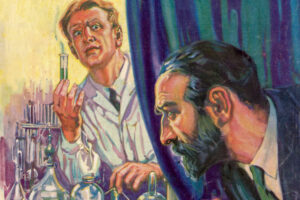 This time, the anniversaries are the Spicy pulps and Fiction House, as well as the accompanying ERBFest, focused on the 100th anniversary of hardcover publication of The Land That Time Forgot.
This time, the anniversaries are the Spicy pulps and Fiction House, as well as the accompanying ERBFest, focused on the 100th anniversary of hardcover publication of The Land That Time Forgot.
For the Spicys, we get a trio of articles. From Ed Hulse, in a reprint from his own zine, Blood ‘n’ Thunder, we get a look at ashcan issues that helped launch the spicys. For those not aware, “ashcan” issues were tryout issues used to secure trademarks. Often they were not sold. While I am aware of their use in comics, this is one of the rare times they were used in the pulps.
Alfred Jan does a re-examination of Culture Publications’ Spicy Mystery Stories and some of the ways it was different from the other Spicy mags. And in a reprint from The Author & Journalist from 1935, we have Willard Hawkins looking at what was, and wasn’t, acceptable for Spicy Detective. Yes, there were things they wouldn’t do.
ERBFest is one of a couple of partner cons held at Pulpfest. Obviously, this one is focused on Edgar Rice Burroughs. Here we get a couple of articles focused on the Caspak trilogy. I’m not certain if I’ve read the whole series (this would have been back in high school), though I did see the two movies based on it.
Henry G. Franke III examines the alternate evolutionary path that is at the heart of the Caspak trilogy. This, to me, was one of the more bizarre aspects of the series, with creatures individually evolving from anthropoid apes up to modern humans and sometimes on to wieroos. Yet the humans were able to have human children.
And Jess Terrell writes about the bat-like wieroos, which sit at the top of the evolutionary ladder in the trilogy. But yet, if they were at the top, why are they all male and with no females or the ability to have offspring?
We continue the examination of Fiction House with a pair of articles. Michael Chomko gives us the third of his articles on FH with their decline and fall, covering the 1940s until it ended in 1955. This touches on several of the major authors of that period. Bill Lampkin writes about Thurman T. Scott, FH’s publisher, focusing on the plantation he purchased in south Georgia to relax at, soon becoming active farming there.
The rest of The Pulpster #33 is rounded out by several other articles.
Will Murray has two articles. One looks into the question of why pulps are so scarce. Some may or may not be surprised at the answers to that. And the other looks into who was Secret Agent X, a pulp hero that we never learned their true identity. But one story may have revealed it. Or did it?
Tony Davis writes about Canadian pulps, a topic I’ve seen more and more on in recent years. John C. Bruening tells us about pulp author Frederick Nebel, whom both Steeger Books and Black Dog Books have reprinted. He wrote hard-boiled detective stories as well as adventure and aviation tales. Kurt Brokaw has an interesting question: Which is worth more, the five issues of Black Mask that ran “The Maltese Falcon” serial, or a first edition of the hardback book?
As always, it’s a good issue, and as always it ends with info on several pulpsters who have left us. I’m most saddened by the passing of Rick Lai, as I am behind in getting out some reviews on his works. Others include Cat Jaster, Brian Lumley, and Ginger Johnson, widow of Tom Johnson. All will be missed.
I do look forward to attending this year’s Pulpfest. And I hope I can get out to a Windy City Pulp and Paper Convention at some point.




[…] (Pulp Super-Fan): For PulpFest 2024, we have The Pulpster #33, the convention book. This one comes in at 64 pages. […]